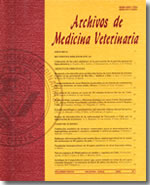Estudio anual de la eliminación de huevos y ooquistes de parásitos gastrointestinales y larvas de nemátodos pulmonares en ovinos de una estancia en Magallanes, Chile
Contenido principal del artículo
Resumen
Con el fin de recabar antecedentes epidemiológicos sobre las endoparasitosis del ovino en Magallanes, XIIª Región de Chile, se trabajó en la estancia "Entre Vientos", comuna de Río Verde, durante un año (septiembre de 1999 a agosto del 2000). A partir de animales de 3 categorías de edad mantenidos bajo un sistema de explotación extensiva, compuestos por 9.800 corderos (nacidos durante la primavera de 1999), 1.800 borregas (1 año de edad) y 13.500 ovejas (2 o más años de edad), se determinaron las tendencias de eliminación de huevos, ooquistes y larvas de parásitos gastrointestinales y pulmonares.
Cada 14 días se obtuvo materia fecal desde el recto de 25 animales pertenecientes a cada grupo de edad, muestreados al azar, para realizar recuentos de huevos y diferenciación de larvas de nemátodos gastrointestinales, recuentos de huevos de cestodos, determinación de animales positivos a ooquistes de protozoos intestinales y detección de larvas de nemátodos pulmonares.
Los corderos presentaron las mayores eliminaciones de huevos de nemátodos gastrointestinales durante el verano, con predominancia de los géneros Nematodirus y Ostertagia. En borregas y ovejas, las mayores eliminaciones de Ostertagia y Trichostrongylus se produjeron en primavera, coincidiendo con el alza de la temperatura ambiental. La categoría más contaminante fue la de las ovejas en primavera, mientras que los corderos lo fueron en el verano. Durante la primavera, la mayor parte de los animales eliminó ooquistes de Eimeria spp., pero fueron los corderos los mayores contaminantes. La mayor oviposición de huevos de Moniezia expansa se registró en corderos y borregas, durante el verano y primavera respectivamente. Larvas de Dictyocaulus filaria se detectaron principalmente en corderos durante el otoño e invierno.
No se diagnosticaron casos de parasitosis clínicas durante los meses del estudio, lo que se puede explicar dado el sistema de crianza extensivo y al traslado estacional de los animales sobre toda la superficie de la estancia.

